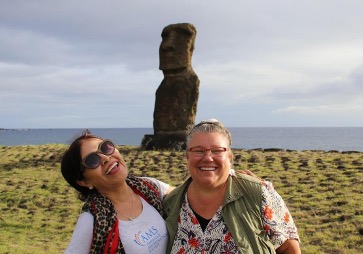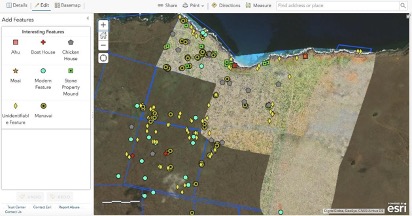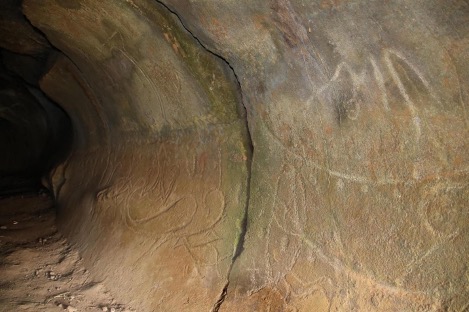- About MAA
- Membership
- MAA Publications
- Periodicals
- Blogs
- MAA Book Series
- MAA Press (an imprint of the AMS)
- MAA Notes
- MAA Reviews
- Mathematical Communication
- Information for Libraries
- Author Resources
- Advertise with MAA
- Meetings
- Competitions
- Programs
- Communities
- MAA Sections
- SIGMAA
- MAA Connect
- Students
- MAA Awards
- Awards Booklets
- Writing Awards
- Teaching Awards
- Service Awards
- Research Awards
- Lecture Awards
- Putnam Competition Individual and Team Winners
- D. E. Shaw Group AMC 8 Awards & Certificates
- Maryam Mirzakhani AMC 10 A Awards & Certificates
- Two Sigma AMC 10 B Awards & Certificates
- Jane Street AMC 12 A Awards & Certificates
- Akamai AMC 12 B Awards & Certificates
- High School Teachers
- News
You are here
Mathematical Mysteries of Rapa Nui with Classroom Activities: Introduction
E ono kope o ruŋa: e hā taŋata, e tahi vi’e, ‘e he poki e tahi.
There were six people on board: four men, one woman, and one child. [Pakomio Ika 1984]
Formed by now inactive volcanic activity, Rapa Nui, or Easter Island as it became known, lies more than 2,200 miles off the Chilean coast and 1,300 miles from the nearest inhabited land, Pitcairn Island. Rapa Nui also sits at the southeasternmost point of the Polynesian Triangle. The island entered written history on Easter Sunday, April 5, 1722, when it was sighted by a Dutch fleet commanded by Jacob Roggeveen. The island was again visited in 1770 by a Spanish expedition led by Don Felipe González, followed by James Cook in 1774 and Count La Pérouse in 1786.
The name Rapa Nui is used to name both the island and its people. The language of the Rapa Nui people is Rapanui, meaning “great Rapa.” The meaning of the word "Rapa" is unknown; however, Rapa is the name of the southernmost island in French Polynesia [Kieviet 2017, 1]. Sources do not agree about the actual number of speakers of Rapanui, with estimates varying between 1,000 and 2,500 speakers.

Figure 2. Ximena Catepillán and Cynthia Huffman on Rapa Nui in July 2019.
We visited the island in July 2019 with a group led by archaeologist Dr. Edwin Barnhart from Ancient Explorations. The group included three mapping experts from Tukuh Technologies, a tribally-owned business located in Kansas City, MO. The mapping was conducted with two fixed-wing unmanned aircraft systems (UAS), commonly known as drones. The drones captured high-resolution orthoimagery of the archaeological sites. The laser beams of LiDAR technology (Light Detection and Ranging) were used to provide 3-D point cloud data of some of the caves on the island.


Figure 3. (Left) Ximena Catepillán launching a fixed-wing drone for photogrammetry of an area of the island.
(Right) Cynthia Huffman wearing a 50-lb $250,000 backpack with LiDAR technology.
After the trip, participants (including Drs. Catepillán and Huffman) were allowed to assist the team from Tukuh Technologies in locating archaeological features from the drone images. Below is a screenshot of the identification work in progress.

Figure 4. Example of identifying and mapping archaeological features. Courtesy of Tukuh Technologies, LLC.
Although Rapa Nui is famous for its monumental statues—or moai—it also has many lava tube caves with a great number of petroglyphs, and some pictographs, displaying a variety of motifs. In fact, Rapa Nui has one of the richest collections of such rock art in Polynesia. The cave Ana O Keke (Cave of the Virgins) was one of the sites visited by the surveyors and members of our group. This cave, whose small entrance borders a cliff, is seldom visited by tourists because of its difficult and dangerous access. It is located at the northeast end of the Poike volcano, on the east side of Rapa Nui, and it has a panel of petroglyphs on the right side of its entrance.

Figure 5. Entrance panel at Ana O Keke. Photo by Robert Tidwell.
The language of the Rapanui belongs to the family of Eastern Polynesian languages, a branch of the Austronesian languages. According to linguists, the first peoples arrived in approximately 400 CE. However, archaeologists date their arrival between 700 and 800 CE, although they agree the peoples quite possibly originated from East Polynesia. The Rapanui number system is decimal and almost identical to the Tahitian number system.
Ximena Catepillán (Millersville University), Cynthia Huffman (Pittsburg State University) and Scott Thuong (Pittsburg State University), "Mathematical Mysteries of Rapa Nui with Classroom Activities: Introduction," Convergence (March 2021)




